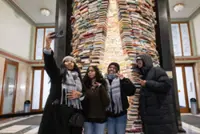The 'Kaki Lima Stories' book has both retrospective and forward-looking views on how five-foot ways fit into Malaysian society. Photo: Aiman Mos Johari
How many of us really take the time to explore and truly acquaint ourselves with the cities we live in?
In our haste to get from Point A to Point B, we tend to simply rush past and overlook our surroundings.
Already a subscriber? Log in
Save 30% OFF The Star Digital Access
Cancel anytime. Ad-free. Unlimited access with perks.





